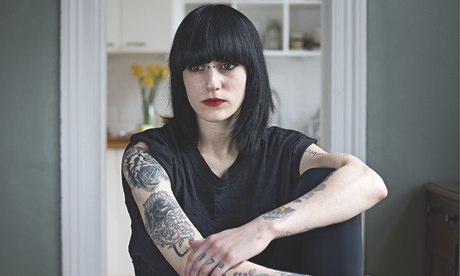 Painted ladies: why women get tattoos
Painted ladies: why women get tattoos
Article by: The Guardian
December 15, 2013
The first tattoo I ever saw belonged to my grandad. He had it done in Scotland during his national service in the 50s, so the tattoo must have been more than 30 years old when I became fascinated by it. I used to ask him to roll up his shirtsleeve and I would use my finger to follow the outline of a woman cheekily reclining in a margarita glass. The shading that was supposed to indicate the flirty curl of the woman's toes had become a faded, bluish blur. Now and again, he'd wink and say it was a picture of my granny. She would purse her lips in pretend disapproval. My grandad died over 15 years ago and I'd have to look at a photograph to remember the details of his face, but I can always remember that tattoo.
I was raised in a religious household where tattoos were verboten; the body was a temple and women even hesitated over piercing their ears. Modesty in all things was required, especially for girls, and a flash of colour on the skin was a desecration of a holy vessel made in God's image. So I went and had my first tattoo done when I was 16. I was out on my own for the first time, throwing myself headlong into making my mark, and letting the world mark me.
My college had a small fund for students in dire financial circumstances. At the beginning of the year, I was given a cheque for £50 and told to spend it on books. I did. At the end of the year, the fund had been underspent and what was left was divided between the students who'd already received an allowance from it. I took my £300 and went to Manchester with my best friend. We bought books, clothes and tattoos: I got a star on my back, he got something similar, but not matching, on his upper arm.
On the train home, we peeled off our dressings to admire and compare. The parlour wasn't exemplary: the tattooist should have asked my age and turned me away, and I certainly wouldn't be so impulsive now. But even so, my star reminds me of the most enduring friendship I've had, the optimism that characterised my late teen years and my innate disobedience. These are all good things, and none of them, like the tattoo itself, is an aspect of myself I'd want to rub out and forget. It wasn't rebellion, it was reclamation. My first mark reads: this skin is mine.
But what if a tattoo turns out to be a mistake – not a mark, but a scar? Despite the increasing availability of procedures aimed at removing tattoo ink from the skin, most of us go under the gun knowing full well that the image will be permanent – that's part of the attraction. I've heard plenty of jokes about impulsive engravings of a beloved's name, resolved with expensive cover-up work once the relationship has ended.
When I was 19, I went to a studio in Cambridge with my then boyfriend and we had simple circles tattooed on the inside of our wrists. The ink lasted longer than the relationship did – of course, that's what happens when you're too optimistic for your own good – but the tattoo is no less important for that. Our daughter likes to trace the circle on my wrist with her finger and hear the story about why and how we got them. Relationships come and go, but some people's histories are always entwined with each other, and some of us like to write our histories on our skin. This mark reads: you were here.
Tattoos can be useful or beautiful or a combination of the two. That's reason enough. Sailors used to get images of Christ inked on to their backs to make the first mate reluctant to use the whip on them. They'd ask for elaborate designs on their limbs to mark voyages taken and ports visited – a kind of indelible dog tag that, they hoped, would identify a corpse lost at sea and washed ashore. Every mark had a story. The most striking tattoo I've seen is a full back piece depicting a Japanese woman wearing a red, richly patterned kimono, falling open to show her breastfeeding a standing toddler. The woman has the back of her hand over her eyes – bored, perhaps, or frustrated by demands this particular task of motherhood is placing upon her. But she's smiling. The artwork must have taken hours and cost hundreds, if not thousands – the folds of the kimono look like a breeze would lift and ripple them. My daughter liked it, too. She called it "the mummy in the red dress". I had a photograph of it stuck over my writing desk for years.
What if the marks we make on our skin don't stay beautiful? I have a tattoo five inches lower than my belly button – a waxing and waning moon entwined with my daughter's initials. Friends warned me against it. If you get pregnant again, the most imaginative advised, the letters will stretch out like they're written on a blown-up balloon. Even the tattoo artist warned me that the skin was delicate there and the ink might not stand the test of time.
They were right. I did have another child, by a caesarean section, no less, and although the surgeon did her best to avoid the tattoo, complications resulted in a wider-than usual incision. The thick, white scar that denotes my son's entrance into the world runs across the tattoo. The skin around it is dotted with marks where the staples joined me back together, the puckers where the drains at the site of the wound were placed. By some people's standards, this is a mangled piece of body art, not pretty and not sexy. But it was never meant to be those things. I wouldn't dream of having it altered to cover up the record written on my body of what motherhood means. This mark reads: some things hurt.
Some things I have heard about women's tattoos: they are chavvy, common, tasteless. They are a mark of the slut, the slapper, the loose woman. Men's tattoos might be about allegiance to a gang, a subculture, a faith or a family. They might be to memorialise a lover or child, remember a journey, a period of time in prison or a religious conversion. Why are women's tattoos often viewed in terms of their sexual attractiveness, or the indicator they are perceived to give about her availability? Why is women's skin still considered public property she has no right to alter? Apparently, these marks of mine are a waste of money and they're just going to fade, blur and sag.
It's true. The ink will age at the same rate as I do – just like my grandad's did. That's fine with me. The marks aren't decoration, aren't designed to draw the gaze or enhance a feature, and even if they were, what's wrong with skin that looks the age it is, rather than the air-brushed and painted flawlessness of an eternal 20-year-old? What's wrong with bellies, arms and breasts that loosen and relax as the years pass? I want my tattoos to look the age they are.
Of course, there are plenty of reasons to dislike tattoos – like any piece of art, not every style will be to everyone's taste. To some, the permanence will never appeal. Or perhaps there's nothing as beautiful to their eyes as unmarked flesh. Jewish friends have told me they wouldn't dream of having their skin inked, not only knowing but feeling the particular history of forced tattooing, used in concentration and labour camps like branding on cattle. Some women friends consider any form of body modification, from bra-wearing to eyebrow-plucking, to be a betrayal of deeply felt feminist principles.
For others, I suspect the vehement dislike of tattoos is really a fear of women's skin. When a woman makes her own mark on it, she isn't quite as available to receive whatever fantasies you might want to project on to her. If skin is a screen, and a woman writes on it, she is telling the world (or even just herself) that her own standards of attractiveness are more important to her than the standards of anyone else who might cross her path. She is taking ownership.
Some say tattoos are addictive – that it starts with a butterfly on the hip and ends with full sleeves and a septum piercing. Maybe. It's been a while since I was last inked, but I've been planning my next for some time. A compass on my foot. To remind me of where I'm going, and of times I might forget.
Click here to read more: http://www.theguardian.com/fashion/2013/dec/13/painted-ladies-why-women-get-tattoos-inked
Login to comment
Comments
No comments yet.

